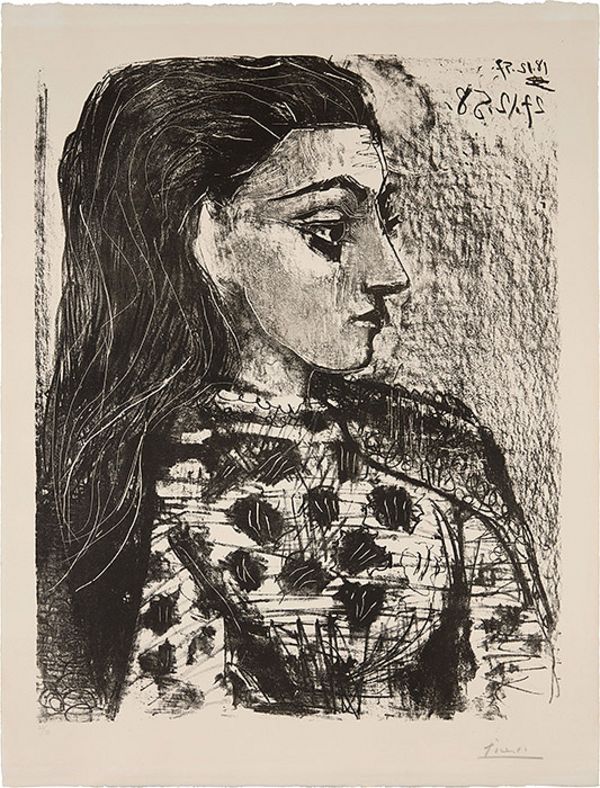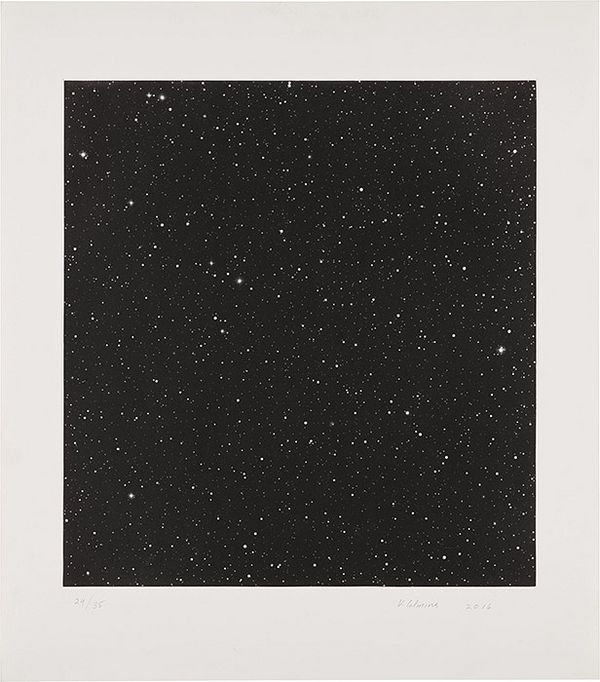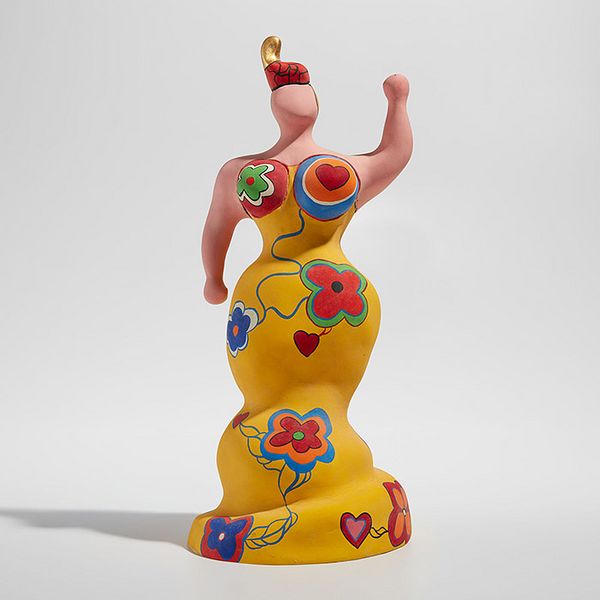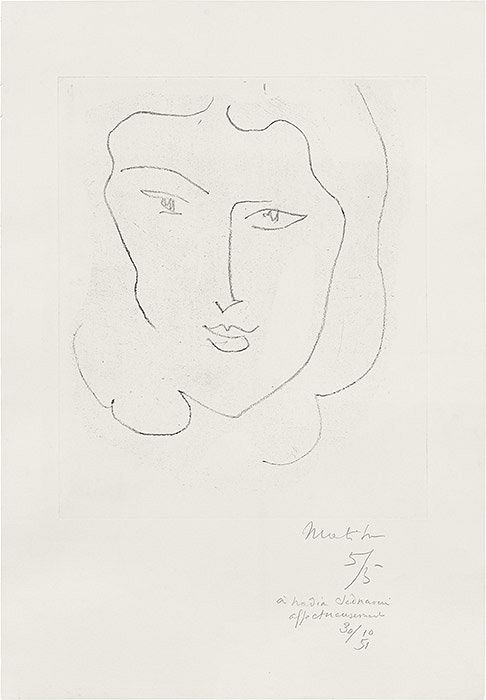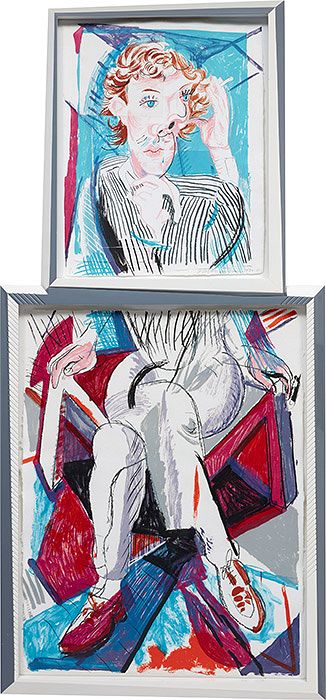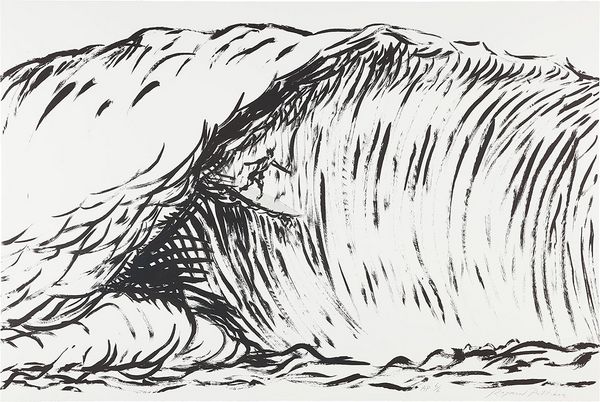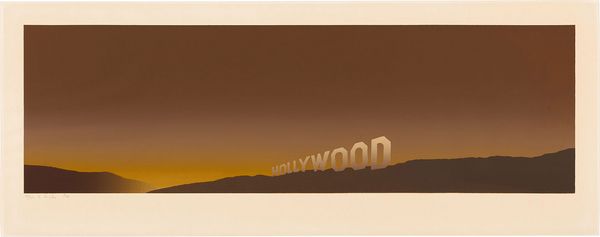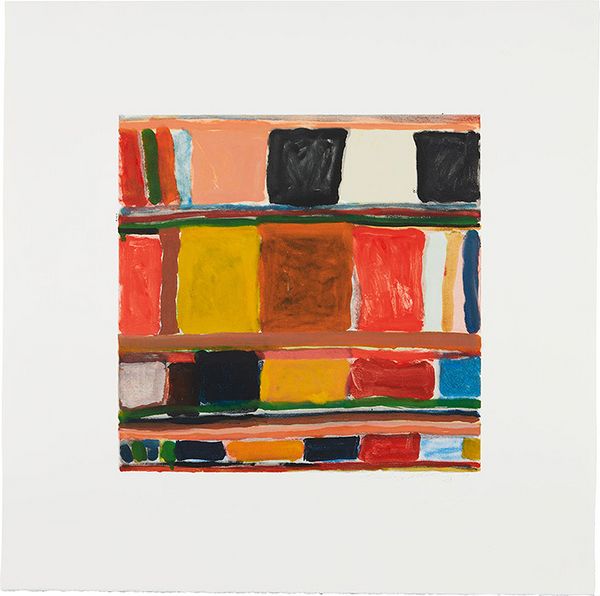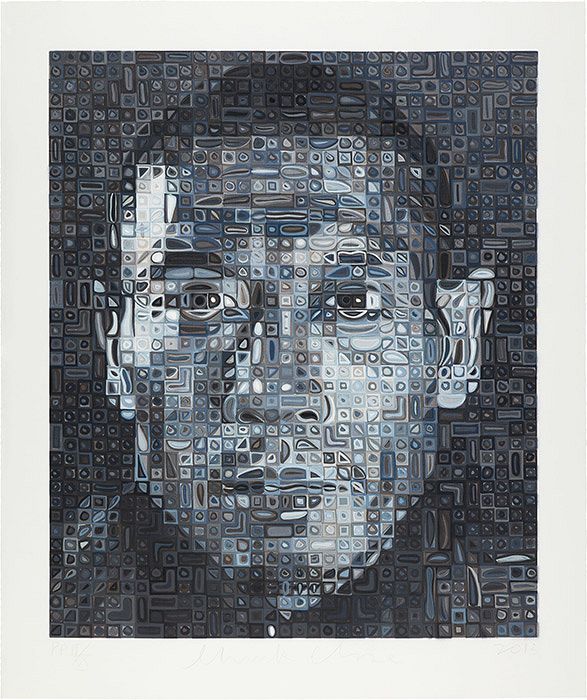Pablo Picasso, Buste au corsage à carreaux (Bust with Checkered Bodice), 1958, lithograph. Editions & Works on Paper.
Of all of Pablo Picasso’s legendary muses, he created the most portraits of his second wife, Jacqueline Roque — nearly 400 in all. Here, in the lithograph featured in our auction (illustrated above), she emerges as a vigorous and elemental force, from her cascading hair to her checkered bodice.
The two met in the summer of 1952 when Jacqueline was working at the Madoura Pottery Studio in Vallauris. They began living together in October 1954, when she was 27 and he was 72. From then, until Picasso’s death in 1973, she was a formidable presence in his life. He often exaggerated her high cheekbones, classical profile, and dark eyes and eyebrows and rendered her as a stylized Mediterranean beauty with long neck and feline face. It’s through the portraits of her that his late style comes into focus.
Andy Warhol, Moonwalk, 1987, screenprint. Editions & Works on Paper.
A vibrant exaltation of NASA’s Apollo 11 moon landing in 1969, Andy Warhol’s Moonwalk is the last print the artist created before his untimely death in 1987.
The moon landing had been among the greatest television spectacles of all time. Warhol intended his commemoration for his planned 1987 portfolio TV, about the history of television in America. It was to have included images of I Love Lucy, Martin Luther King Jr.’s “I Have a Dream” speech, and the Beatles’ first appearance on the Ed Sullivan Show. Moonwalk, however, was the only one of the images he was able to complete.
The image is Warhol's composite: While astronaut Buzz Aldrin and the American flag appeared worldwide on live television, Warhol merged two photos taken by Neil Armstrong which never showed on screen for Moonwalk. This is America winning the Space Race. With his massive infusion of brilliant electric pink and blue — which reads here like a campy variant of patriotic red, white, and blue — Warhol transforms the epic triumph into an RCA picture-tube moment, one giant leap for Pop audiences around the globe.
Vija Celmins, Untitled (Dark Sky 1), 2016, mezzotint. Editions & Works on Paper.
Vija Celmins, on the other end of the spectrum from Andy Warhol, invests reverential awe in the intimate, timeless, and impersonal existential wonders of the universe. The exquisite galactic array of her mezzotint Untitled (Dark Sky 1), featured in our auction, offers a startling vista on forever.
Since the late 1960s, the artist has brought lucid and super-intense focus to an extremely narrow selection of quiet subjects that includes oceans, deserts, spiderwebs, antique writing slates, and star fields. Despite commanding impressive prices on the primary market and enjoying retrospectives at major institutions worldwide, Vija Celmins vehemently resists self-promotion in all its forms and produces a relatively small quantity of work, which makes her refined treasures all the more coveted by those in the know.
Niki de Saint Phalle, Nana rose trophée ou Nana mode (Nana Pink Trophy or Nana Fashion), 1986, hand-painted polyester resin multiple. Editions & Works on Paper.
French-American sculptor Niki de Saint Phalle is unto herself a one-woman festival of fantastic feminist fun. The artist’s career flowered with renewed brilliance on the Continent in the mid-1960s with her ambitious series of monumental and vivacious dancing totems of womanhood. She playfully championed these wonderful women as “Nanas” — French slang which roughly translates as “saucy chicks.”
Jubilant and buoyant celebrations of voluptuous, empowered femininity, they were a testament to her liberated concept that all women are goddesses. In the artist’s most famous exhibition, Hon—en katedral (She—A Cathedral), in 1966 at Stockholm’s Moderna Museet, visitors entered into a world of playful surprises through the open legs of a giant reclining Nana. Featured in our sale is a more intimate tribute — Nana rose trophée, her 15″ high edition of 1984 that she dedicates in an inscription on the underside to the photographer Irving Penn.
Henri Matisse, Jeune femme à la chevelure encadrant le visage (Young Woman with Hair Framing Her Face), 1948, etching. Editions & Works on Paper.
In the etching Jeune femme à la chevelure encadrant le visage, Matisse wields a gentle, confident line of eloquent simplicity to describe the radiant facial contours and coiffure of his beautiful young sitter. He later signed the sheet in pencil in the lower margin, numbered it 5/5, and dedicated it to her, "à Nadia Sednaoui, affectueusement." Matisse’s favorite model of that era — a sophisticated young Egyptian woman who had first laid eyes upon his innovative style in a book back in Cairo during World War II, Nadia appears in a number of his images throughout the summer of 1948, as a spirit of profound ease.
Matisse was introduced to Nadia by his son-in-law, the art critic Georges Duthuit who guessed he would enjoy drawing her. The artist relished their charmed joie de vivre rapport very much indeed, despite the nearly sixty years between them. She, for her part, fancied herself more Matisse’s friend than his model — never imagining herself to be posing for him so much as simply engaging with him in a very natural way. He would then ask her to pause their conversation so that he could draw her for a little bit. Reportedly, when he rang her several weeks before his death, he reiterated once again, “Please always remember the affection I have had for you.”
David Hockney, An Image of Gregory, from Moving Focus, 1984–85, two lithographs with artist's hand-made frame. Editions and Works on Paper.
David Hockney’s An image of Gregory is the artist’s vibrant two-panel portrait of Gregory Evans, his lover, assistant, and companion from 1976 on for nearly a decade.
In the mid-80s, we see Hockney begin to explode Western linear perspective. The print is from the artist’s acclaimed Moving Focus series of 29 lithographs, which he worked on with Tyler Graphics from 1984 through 1986. This is among Hockney’s largest and most ambitious print series and is viewed by many as the culmination of his dialogue with Picasso’s Cubist space.
In An image of Gregory, his multiple viewpoints merge beautifully into one. What comes into focus is a more authentic and natural visual experience that is less familiar and all the more fresh.
Raymond Pettibon, No Title (Hermosa Beach), 2019, lithograph. Editions & Works on Paper.
An instrumental force in helping to flesh out the visual culture of the southern California DIY punk rock scene, Raymond Pettibon is a self-taught artist influenced by comics, cartoons, and other visual ephemera and is associated with American countercultural iconography. The artist first came to attention in the mid-1970s drawing cover art for his brother’s band Black Flagg and later for Sonic Youth, the Minutemen, and the Foo Fighters. It wasn’t long before the art world took notice of his wry, promethean genius and his career’s been in high gear ever since — including such highlights as a major retrospective of his work at the New Museum in 2017.
Among the most popular recurrent motifs in Pettibon’s oeuvre is lone surfers facing off against the epic waves of his hometown Hermosa Beach, California. The artist never intended to make a series of the subject, he insists, but growing up around surfing made the subject a natural for him.
Ed Ruscha, Hollywood, 1968, screenprint. Editions & Works on Paper.
A coy and wondrous emblem of shallow and fabulous Southern California cool, Ed Ruscha’s Hollywood, 1968 is arguably the most iconic print in his gloriously deadpan oeuvre. For generations, the Hollywoodland sign in Los Angeles has been one of America’s most famous landmarks. In effectively coopting it, Ruscha makes it resonate with the vibrant and potent magic of the 1960s and the gallant fun of the LA scene.
The artist brought the print to life using a split-fountain screenprint technique that allowed him to blend colors directly on the screen, giving the golden glowing sky an illusionistic signature style that feels like pure cinematic splendor.
Stanley Whitney, Stay Songs, 2001, monotype. Editions & Works on Paper.
Stanley Whitney’s monotypes, such as Stay Songs of 2001, are immersive and vibrant performative investigations in opacity, density, and hue.
An MFA from the Yale School of Art in 1972, Stanley Whitney is an image maker who has over the course of his fifty-year career been obsessed with nurturing a unique, abstract visual language of his own based on chromatic experimentation and unexpected cadences of color and space. Very much informed by his identity as a Black American and long drawn to the spontaneous improvisational jazz of Charlie Parker, Miles Davis, Ornette Coleman, the artist looks to polyphonic call-and-response traditions in music for clues to authentic and responsive visual poetics and language.
Whitney consolidated his formal approach when he was living and working in Rome during the 1990s. He credits his exposure to Classical Italian architecture and Egyptian hieroglyphs during that time as the source of his discoveries of rhythmic tectonic and partitional structures suffused with different qualities of daylight and shade — a prefiguration of the Modern grid — which he sees as the compositional foundation of his work.
Roy Lichtenstein, Road Before the Forest, from Landscape Series, 1985, lithograph, woodcut and screenprint. Editions & Works on Paper.
In this scenic vista, entitled Road Before the Forest, Roy Lichtenstein punctuates his transcendent evocation of pastoral Pop serenity with asphalt, blue skies, and sunshine.
Rather than describing real places somewhere in the natural world, many of the scenic views in this 1985 Landscape Series are synthetic abstractions without any concrete location or natural reality. To create them, Lichtenstein orchestrated combinations of both realistic-looking and cartoon brushstrokes that he appropriated from his Brushstroke works of the 1960s and employed a rich array of sophisticated printing techniques and optical illusions to make them look robustly hyper-fluid — the pictorial equivalent of splashy onomatopoeic comic book Wows.
Chuck Close, Zhang Huan II, 2013, silkscreen with airbrush. Editions & Works on Paper.
Since initially trading in his brushes for an airbrush back in 1967 in order to engage with the photorealistic image more honestly, Chuck Close just got better and better. By 2013, when this print was published, the rich impression’s organic abstraction inside the individual cells of his grids achieved renewed prominence. His print Zhang Huan II represents an exciting moment in the artist’s style, when the tension between the facture and the image is at its most robust and lively. At middle distance, the composite marks visually resolve into a monumental photorealistic portrait cast in a sparkling aura of bluish light. But come closer and it breaks apart into an intense abstract field of shimmering fluidity.
Close often selected his portrait subjects based on how much he admired their work. He first met the Chinese performance artist and conceptual painter Zhang Huan in September 2007 during Zhang’s exhibition at the Asia Society in New York, later photographing him in May 2008. Through his very meditative and time-consuming process, Close claimed that doing portraits like this was his way of getting to know someone over long stretches of time.
Recommended Reading
